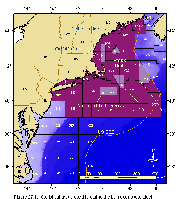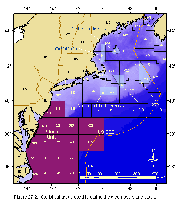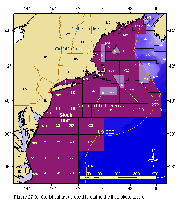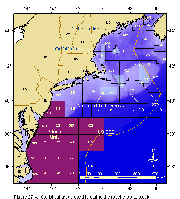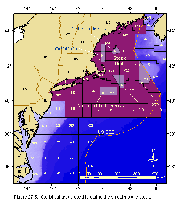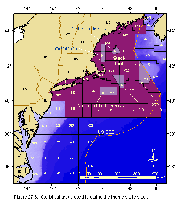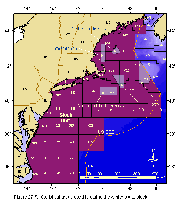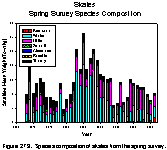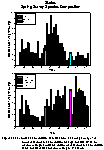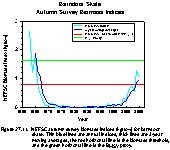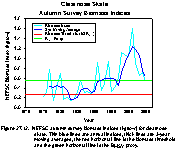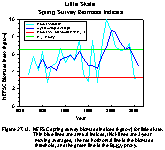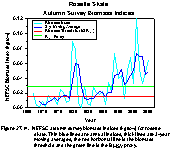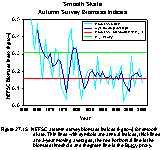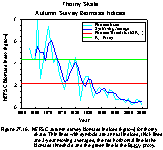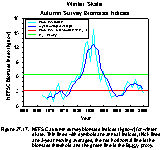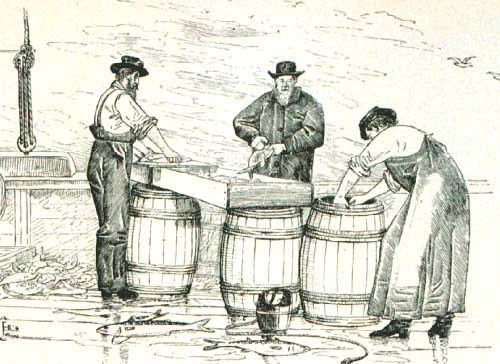
|
Status of Fishery Resources off the Northeastern US NEFSC - Resource Evaluation and Assessment Division |
|||
|
|||
|
Distribution, Biology and Management Skates, Family Rajidae, are distributed throughout the Northwest Atlantic from near the tide line to depths exceeding 700 m (383 fathoms; Bigelow and Schroeder 1953; McEachran 2002). Members of this family lay eggs that are enclosed in a hard, leathery case commonly called a mermaid's purse. Incubation time is at least 6 to 12 months, with the young having the adult form at the time of hatching. There are seven species of skates occurring along the North Atlantic coast of the United States (McEachran and Musick 1975): barndoor skate (Dipturus laevis), clearnose skate (Raja eglanteria), little skate (Leucoraja erinacea), rosette skate (L. garmani), smooth skate (Malacoraja senta), thorny skate (Amblyraja radiata), and winter skate (L. ocellata). |
|
The center of distribution
for barndoor skates
is Georges Bank and Southern New England (Figure
27.1) with some animals occasionally found in
the Gulf of Maine and on the Scotian Shelf. Clearnose skates
are a southern species, occurring primarily in the inshore Middle
Atlantic and inshore Southern New England (Figure
27.2). Little skate are found in all areas but
primarily Georges Bank and Southern New England
(Figure
27.3). Rosette
skates are a southern species, occurring primarily
in deep waters in the Middle Atlantic, Southern New England, and
occasionally off Georges Bank (Figure
27.4). Smooth
and thorny
skates are most commonly found in the Gulf
of Maine (Figure
27.5), (Figure
27.6). The center of distribution for winter
skate is Georges Bank and Southern New England (Figure
27.7), with some animals occasionally found in
the Gulf of Maine, on the Scotian Shelf, and in the Mid-Atlantic.
Skates are not known to undertake large scale migrations, but move
seasonally in response to changes in water temperature, generally
offshore in summer and early autumn and vice versa during winter
and spring. |
Barndoor skate is a large-bodied species reaching sizes of 150 cm (Bigelow and Schroeder 1953) and ages of more than 10 (Gedamke et al. 2005). Males reach sexual maturity at age 6 at a size of 108 cm, while females attain maturity at age 6.5 and 116 cm. Clearnose skate are smaller reaching sizes of 90 cm and live to be around 8 years old (Gelsleichter 1998). Size at first maturity is 56 cm for males and 66-73 cm for females (Sosebee 2005). Little skate is the second smallest skate species reaching sizes around 54 cm (McEachran 2002) and maximum ages between 8 and 12 (Waring 1984; Frisk 2004; Frisk and Miller 2006). Size at first maturity is reached at 39 cm for males and 40-42 cm for females (Sosebee 2005). Rosette skate is the smallest of the seven species and reaches a maximum size of 45-50 cm (McEachran 2002). Sexual maturity occurs at 33 cm for males and 33-35 cm for females (Sosebee 2005). Smooth skate reach a slightly larger size of around 58 cm (McEachran 2002) and size at first maturity occurs at 50 cm for males and 33-48 cm for females (Sosebee 2005). Thorny skate is a large-bodied species with a maximum size of 102 (McEachran 2002) and can live to be age 16 and older (Sulikowski et al. 2005a). Sexual maturity appears to occur over a broad size range (Sosebee 2005) with most mature animals over 80 cm (Sulikowski et al. 2005b). Winter skate are large-bodied as well potentially reaching sizes of 150 cm (McEachran 2002) and ages of about 20 years (Sulikowski et al. 2003; Frisk 2004). Sexual maturity is reached at a large size of around 74 cm at about age 12 (Sulikowski et al. 2004; Frisk 2004; Frisk and Miller 2006). The principal commercial fishing method used to catch skates is otter trawling (NEFSC 2000). Skates are frequently taken as bycatch during groundfishing operations and discarded. Recreational and foreign landings are insignificant. Skates are currently managed under the New England Fishery Management Council's Skate Fishery Management Plan implemented in 2003. This plan includes mandatory reporting by species, possession prohibitions on barndoor, thorny, and smooth skates, trip limits for winter skate, and a suite of measures in other fisheries management plans to aid in the recovery of the overfished skate species. The information provided herein reflects the results of the most recent peer-reviewed assessments for the skate complex (NEFSC 2007). |
| The Fishery Skates have been reported in New England fishery landings since the late 1800s. However, landings (primarily from off Rhode Island) never exceeded more than a few hundred metric tons until the advent of industrial fishery in Southern New England in the1950s followed by the distant water fleets during the 1960s. Commercial landings peaked in 1969 at 9,500 mt and again in 1972 at 8,800 mt, declined quickly during the early and mid-1970s, and fell to a low of 500 mt in 1981 (Table 27.1; Figure 27.8 [Fig 27.8 Data]). Reported landings have since increased substantially, partially in response to increased demand for lobster bait and to increased export markets for skate wings, but also due to improved statistical data collection. Wings are taken from winter and thorny skates, the two species currently known to be used for human consumption. Bait landings appear to be primarily from little skate, based on areas fished and known species distribution patterns. Landings increased to 12,900 mt in 1993, declined somewhat to 7,200 mt in 1995, and subsequently rose sharply to average 13,000 mt during 1996-1998. Landings have since continued to increase and are now averaging around 15,000 mt. Research Vessel Survey Indices NEFSC spring survey biomass indices for these seven skate species as a group indicate that the skate complex is presently at a medium level of biomass (Figure 27.9 [Fig 27.9 Data]). NEFSC spring survey biomass indices were relatively stable from 1968 to 1980, increased to peak levels in the 1980s, and then declined steadily until 1994. Subsequently, the indices increased through 1999 and have since slightly decreased. The large increase in biomass in the early to mid-1980s was dominated by winter and little skate. Biomass indices of the large-sized skates (barndoor, winter, and thorny) declined from the mid 1980s to the mid-1990s (Figure 27.10 [Fig 27.10 Data]), and have since been stable. Biomass indices of the smaller skates (little, clearnose, rosette, and smooth, mainly little skate) increased from 1980 through the mid-1990s (Figure 27.10 [Fig 27.10 Data]) but have declined from 1999 onwards. | 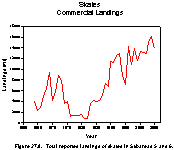 Figure 27.8 |
| Biological
Reference Points Biomass reference points are based entirely on NEFSC survey data since reliable landings and discard information are not available by species. For all species but barndoor, the Bmsy proxy is defined as the 75th percentile of the appropriate survey biomass index time series for that species (Table 27.2). For barndoor skate, the Bmsy proxy is the average of 1963-1966 autumn survey biomass indices since the survey did not catch barndoor for a protracted period. The fishing mortality reference points are based on changes in survey biomass indices. If the three-year moving average of the survey biomass index for a skate species declines by more than the average CV of the survey time series, then fishing mortality is assumed to be greater than Fmsy and overfishing is occurring for that skate species. The average CVs of the indices are given by species in Table 27.2. |
| Barndoor
Skate
NEFSC autumn survey biomass indices of barndoor skate declined continuously through the 1960s, and reached historic lows during the early 1980s (Figure 27.11 [Fig 27.11 Data]). Since 1990, the biomass index increased on Georges Bank, the western Scotian Shelf, and off Southern New England. However, the 2005 index is still less than 50% of the peak observed in 1963. The 2003-2005 average survey biomass index of 0.96 kg/tow is above 50% of the Bmsy proxy (1/2 Bmsy = 0.81 kg/tow), which is the biomass threshold reference point. Thus, barndoor skate is not overfished, but is not yet rebuilt to Bmsy. Since the 2003-2005 average index is higher than the previous 3-year average index (2002-2004) of 0.88, overfishing is not occurring. | |
|
NEFSC autumn survey biomass
indices increased from the mid 1980s to 2000 (Figure
27.12 [Fig
27.12 Data]), but have since declined. The 2003-2005 average
biomass index of 0.63 kg/tow is above both the biomass threshold
reference point (0.28 kg/tow) and the Bmsy proxy (0.56
kg/tow), and hence the species is not overfished. The 2003-2005
index is lower than the 2002-2004 index of 0.75 by 16% but not by
30% (the average CV), and therefore overfishing is not occurring. | |
|
NEFSC spring survey indices
of little skate biomass increased in the early 1980s to 1999 but
have since decreased (Figure
27.13 [Fig
27.13 Data]). The 2004-2006 average biomass index of 4.59 kg/tow
is above the biomass threshold reference point (3.27 kg/tow), and
thus the species is not overfished. The 2004-2006 index is lower
than the 2003-2005 index of 5.65 by 19%, but overfishing is not
occurring as this decline is slightly less than 20%. | |
|
NEFSC autumn survey biomass
indices of rosette skate have been increasing since 1986 (Figure
27.14 [Fig
27.14 Data]). The 2003-2005 average biomass index of 0.049 kg/tow
is above both the biomass threshold reference point (0.015 kg/tow)
and the Bmsy proxy (0.029 kg/tow), and thus the species
is not overfished. The 2003-2005 index is above the 2002-2004 index
of 0.045, and therefore overfishing is not occurring. | |
|
NEFSC autumn survey biomass indices of smooth skate
were highest during the early 1960s and late 1970s (Figure
27.15 [Fig
27.15 Data]), but have been stable at a lower level since the
mid-1980s. The 2003-2005 average biomass index of 0.178 kg/tow is
slightly above the biomass threshold reference point (0.16 kg/tow)
and thus the species is not overfished. The 2003-2005 index is above
the 2002-2004 index of 0.172, and therefore overfishing is not occurring. | |
|
NEFSC autumn survey biomass indices of thorny skate
have declined since the 1960s and are now at historic lows (Figure
27.16 [Fig
27.16 Data]). The biomass is about 10% of the peaks observed
in the late 1960s. The 2003-2005 average biomass index of 0.56 kg/tow
is well below the biomass threshold reference point (2.20 kg/tow),
indicating that the species is in an overfished condition. The 2003-2005
index is lower than the 2002-2004 index by 11%, but overfishing
is not occurring as this is less than the reference decline of 20%. | |
|
NEFSC autumn survey biomass indices of winter skate peaked in the mid-1980s, declined through the early 1990s, and have since stabilized at a moderately higher levels (Figure 27.17 [Fig 27.17 Data]). The 2003-2005 average biomass index of 3.34 kg/tow is slightly above biomass threshold reference point (3.23 kg/tow), and thus the species is not overfished. The 2003-2005 index is below the 2002-2004 index by 23%, and therefore overfishing is occurring as this change exceeds the 20% reference decline level.
|
Summary
Of the seven species of
skate that occur off the Northeastern United States, one species,
thorny skate, remains in an overfished condition, four species (barndoor,
winter, smooth, and little) are at biomass levels between the biomass
threshold and the Bmsy proxy, and two species (clearnose
and rosette) are at biomass levels that exceed the Bmsy
proxy. For one species, winter skate , overfishing is occurring. |
| For further information Bigelow, H. B., and W. C. Schroeder. 1953. Fishes of the Gulf of Maine. Fish. Bull., U.S. Fish. Wildl. Serv. 74(53). 577 p. Frisk, M.G. MS. 2004. Biology,
life history and conservation of elasmobranchs with an emphasis
on western Atlantic skates. PhD. Dissertation. University of Maryland Gedamke, T., W. D. DuPaul, and J.A. Musick. 2005. Observations on the life history of the barndoor skate, Dipturus laevis, on Georges Bank (Western North Atlantic) J. Northw. Atl. Fish. Sci. 35: 67-78. Gelsleichter, J.J. 1998. Vertebral Cartilage of the Clearnose Skate, Raja eglanteria: Development, Structure, Ageing, and Hormonal Regulation of Growth. PhD. Dissertation. College of William and Mary, 215 p. McEachran, J. D. 2002. Skates. Family Rajidae. p. 60-75. In: Bigelow and Schroeder’s fishes of the Gulf of Maine. 3rd Edition. B. B. Collette and G. Klein-MacPhee (eds.). Smithsonian Institution Press, Washington D.C., 748 p. McEachran, J. D., and J. A. Musick. 1975. Distribution and relative abundance of seven species of skates (Pisces: Rajidae) which occur between Nova Scotia and Cape Hatteras. Fish. Bull. (U.S.), 73: 110-136. NEFSC [Northeast Fisheries Science Center]. 2000. [Report of the] 30th Northeast Regional Stock Assessment Workshop (30th SAW) Stock Assessment Review Committee (SARC) consensus summary of assessments. Northeast Fish. Science Center Ref. Doc. 00-03. 477 p. NEFSC [Northeast Fisheries Science Center]. 2007. 43rd Northeast Regional Stock Assessment Workshop (43rd SAW) 43rd SAW Assessment Report. Northeast Fish. Science Center Ref. Doc. 07-xx. xx p. Sosebee, K.A. 2005. Maturity of skates in Northeast United States waters. J. Northw. Atl. Fish. Sci. 35:141-153. Sulikowski, J.A., J. Kneebone, S. Elzey, J.Jurek, P.D. Danley, W.H. Howell, and P.C.W. Tsang. 2005a. Age and growth estimates of the thorny skate (Amblyraja radiata) in the western Gulf of Maine. Fish. Bull. 103:161-168. Sulikowski, J.A., J. Kneebone, S. Elzey, J.Jurek, P.D. Danley, W.H. Howell, and P.C.W. Tsang. 2005b. The reproductive cycle of the thorny skate (Amblyraja radiata) in the western Gulf of Maine. Fish. Bull. 103:536-543. Sulikowski,JA, M.D. Morin, A.H. Suk, and W.H. Howell. 2003. Age and growth estimates of the winter skate (Leucoraja ocellata) in the western Gulf of Maine). Fish Bull. 101:405-413. Sulikowski, J.A., P.C.W. Tsang, and W.H. Howell. 2004. An annual cycle of steroid hormone concentrations and gonad development in the winter skate, Leucoraja ocellata, from the western Gulf of Maine. Mar. Biol. 144:845-853. Waring, G. T. 1984. Age, growth and mortality of the little skate off the northeast coast of the United States. Trans. Amer. Fish. Soc. 113:314 321. |
Return to Status of Fishery Resources off the Northeastern US
www.nefsc.noaa.gov
Search
Link Disclaimer
webMASTER
Privacy Policy
(Modified Apr. 12 2007)
 Main Page
Main Page


